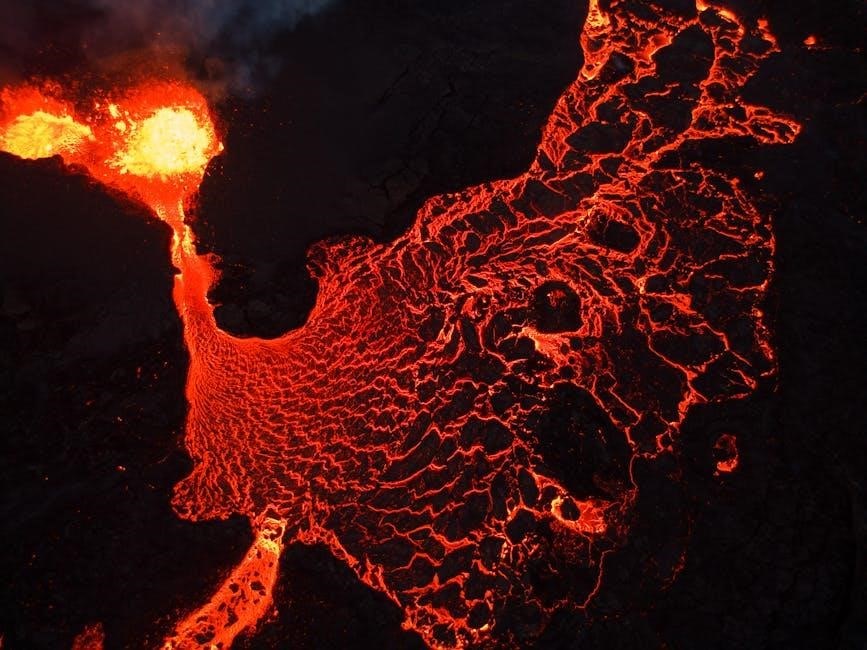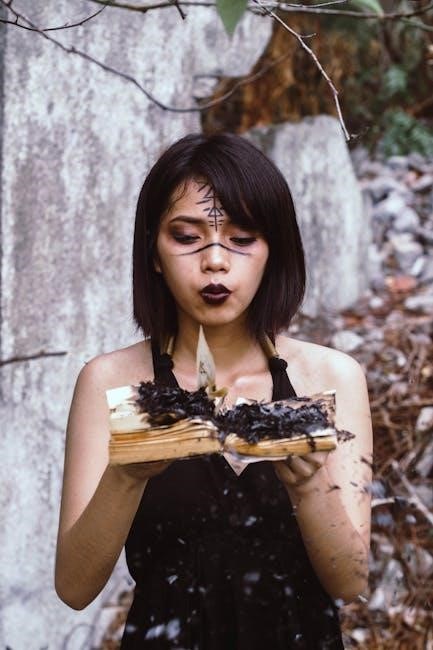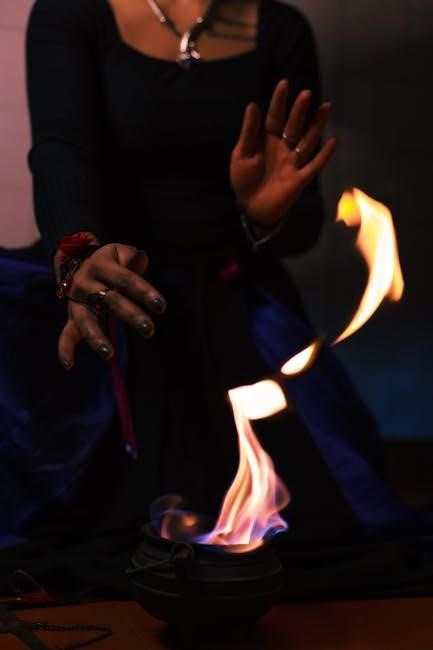
A Witch’s Guide to Burning by Aminder Dhaliwal is a captivating graphic novel blending prose, illustrations, and comics. It follows Singe, a young witch burned at the stake, as she embarks on a journey of healing and self-discovery, exploring themes of burnout and recovery in a magical world.
Overview of the Book
A Witch’s Guide to Burning is a unique blend of prose, comics, and illustrations, set in a magical world where witches and fire coexist. The story follows Singe, a young witch burned at the stake, as she navigates a journey of healing and self-discovery. This emotional and adventurous tale explores themes of burnout, recovery, and identity. Published by Drawn & Quarterly, it’s a captivating hybrid narrative that appeals to readers of all ages with its rich visuals and heartfelt storytelling.
Setting and Premise
A Witch’s Guide to Burning unfolds in a magical realm where fire and witches dominate the landscape. The story begins in Chamomile Valley, where a witch named Singe survives a burning ceremony interrupted by rain. Left without magic or memories, Singe embarks on a journey of recovery with Yew-Veda, a witch doctor, and Bufo Wonder, a toad. This whimsical world, filled with danger and adventure, explores themes of healing and identity in a society grappling with burnout and self-care.

Author Background
Aminder Dhaliwal is a Canadian cartoonist and animator, known for her graphic novel Woman World. She works at Disney TV Animation and was named a writer to watch by CBC Books in 2019.
Aminder Dhaliwal’s Profile
Aminder Dhaliwal, a Canadian-born cartoonist and animator, gained recognition for her Instagram series Woman World, later published as a graphic novel. Now based in Los Angeles, she works as a director at Disney TV Animation. Her unique storytelling blends humor and social commentary, making her a prominent figure in contemporary comics. Dhaliwal’s work often explores themes of identity, culture, and societal issues through whimsical narratives and striking visuals.
Previous Works and Recognition
Aminder Dhaliwal’s debut graphic novel, Woman World, gained widespread acclaim after originating as an Instagram series. Published by Drawn & Quarterly in 2018, it earned her recognition as a fresh voice in comics. CBC Books named her a “writer to watch” in 2019. Dhaliwal’s work often combines humor with sharp social commentary, solidifying her reputation as a rising talent in both animation and graphic storytelling.

Plot Overview
A Witch’s Guide to Burning follows Singe, a witch stripped of her magic, as she embarks on a journey of healing and self-discovery, exploring themes of burnout and recovery.
Main Plot: Singe’s Journey
Singe, a young witch, is burned at the stake, losing her magic and memories. Rescued by Yew-Veda, a witch doctor, and Bufo Wonder, a toad, she embarks on a journey to recover her identity and powers. Crossing dangerous landscapes, they battle demons and confront challenges, blending humor with deeper themes of healing and self-discovery. This allegorical tale explores burnout and recovery, set in a magical world where witches and fire intertwine, offering a unique perspective on sacrifice and growth.
Character Development: Singe and Companions
Singe, a young witch stripped of her magic and memories, evolves from a broken individual to a resilient hero. Her journey is enriched by Yew-Veda, a wise witch doctor, and Bufo Wonder, a charming toad with a knack for humor. Together, they navigate challenges, with Yew-Veda offering guidance and Bufo providing comedic relief. Their bond highlights themes of friendship and healing, as Singe gradually regains her identity and learns to embrace her powers anew.

Themes and Symbolism
A Witch’s Guide to Burning explores burnout and self-care through magical allegories. Fire and witches symbolize societal pressures and personal healing, blending fantasy with real-world themes.
Burnout Allegory in Modern Society

A Witch’s Guide to Burning serves as a poignant allegory for modern burnout, where witches represent overburdened individuals drained by societal demands. Singe’s loss of magic mirrors the exhaustion of those overwhelmed by endless responsibilities, while her journey symbolizes the struggle to reclaim one’s identity and heal from the pressures of a demanding world. The narrative underscores the urgent need for self-care and balance in a society that often prioritizes productivity over well-being. Fire, both destructive and transformative, becomes a powerful metaphor for the consequences of neglecting mental and emotional health, urging readers to reflect on their own capacity for resilience and recovery in the face of unrelenting expectations. Dhaliwal’s whimsical yet profound storytelling highlights the universal quest for restoration and the importance of recognizing one’s limits in a culture that often glorifies burnout. Through Singe’s trials, the book challenges readers to confront the reality of their own vulnerabilities and the necessity of embracing healing as a form of resistance against the relentless demands of modern life. The blending of humor and heartache creates a relatable and impactful commentary on contemporary struggles, inviting readers to reconsider their relationship with work, rest, and personal fulfillment. By framing burnout within a magical realm, Dhaliwal offers a fresh perspective on a pervasive issue, making the allegory both accessible and deeply resonant. Ultimately, the story suggests that healing is not a solitary or shameful process but a necessary journey toward reclaiming one’s power and rediscovering one’s true self.
The Metaphor of Healing and Recovery
A Witch’s Guide to Burning intricately weaves the metaphor of healing through Singe’s journey. Her physical recovery from being burned symbolizes the emotional and mental restoration needed after burnout. The story emphasizes that healing is a slow, painful, yet transformative process, requiring patience and support. Singe’s quest to regain her magic mirrors the struggle to reclaim one’s identity and strength after loss. The narrative underscores that recovery is not just about regaining what was lost but also about discovering new facets of oneself, highlighting the resilience of the human spirit in the face of adversity. Through her companions, Yew-Veda and Bufo Wonder, the story illustrates the importance of guidance and camaraderie in the healing process, suggesting that recovery is rarely a solitary journey but one enriched by the presence of others who offer care and understanding. The magical elements serve as a powerful allegory for the internal battles and triumphs experienced during personal growth, reminding readers that healing is a journey of self-discovery and renewal. The blend of whimsy and depth in Dhaliwal’s storytelling makes the metaphor both relatable and profound, offering readers a compelling reflection on the nature of recovery and the path toward wholeness. By framing healing as a multifaceted and ongoing process, the book provides a hopeful yet realistic perspective on the challenges and rewards of mending oneself in a world that often prioritizes productivity over well-being. The use of fire and magic as symbols of both destruction and rebirth further reinforces the idea that healing is not about erasing scars but about learning to live with them and finding strength in their presence. Ultimately, Singe’s journey suggests that true recovery lies in embracing the journey, flaws and all, and finding the courage to rise from the ashes anew.

Art and Style
A Witch’s Guide to Burning showcases a lavish blend of prose, illustrations, and comics, with cinematic effects and venturesome typography, creating a visually stunning hybrid narrative experience.
Graphic Novel Elements and Illustrations
A Witch’s Guide to Burning captivates with its graphic novel elements, featuring riveting illustrations that incorporate cinematic techniques like fades and flashbacks. The artwork blends seamlessly with the narrative, creating an immersive experience. Typographically adventurous, the text enhances the story’s emotional depth. Serialized initially on Instagram, the visuals were fine-tuned for digital engagement, ensuring dynamic storytelling. Dhaliwal’s style brings the magical world to life, making the graphic novel a standout in both form and function.
Blending Prose and Comics
A Witch’s Guide to Burning uniquely merges prose and comics, creating a dynamic narrative experience. Serialized on Instagram, the format enhances storytelling through text and visuals. The interplay between typographically venturesome prose and vibrant illustrations deepens emotional engagement. Dhaliwal’s approach seamlessly integrates both mediums, crafting a compelling tale that feels both intimate and expansive, making it a standout in hybrid storytelling.

Characters
Singe, a young witch, loses her magic and memories after being burned at the stake. She is joined by Yew-Veda, a wise witch doctor, and Bufo Wonder, a transformed witch, on her journey of recovery and discovery.
Singe: The Protagonist
Singe, the protagonist, is a young witch who suffers a tragic fate when her magic is stripped away during a burning ceremony. Left amnesiac and physically scarred, she embarks on a journey to reclaim her identity and powers. Her story serves as a metaphor for burnout and resilience, highlighting themes of self-discovery and healing. Through her struggles, Singe evolves from a broken individual to a determined survivor, making her a compelling and relatable character.
Yew-Veda: The Witch Doctor
Yew-Veda is a wise and skilled witch doctor who plays a pivotal role in Singe’s journey. With her deep knowledge of healing and magic, she helps Singe recover from her traumatic burning ceremony. Yew-Veda’s guidance and wisdom are crucial as Singe navigates her quest to regain her memories and powers. Alongside Bufo Wonder, her eccentric toad companion, Yew-Veda provides both support and occasional frustration, making her a complex and memorable character in the story.
Bufo Wonder: The Transformed Witch
Bufo Wonder is a charming yet bumbling witch who has accidentally turned himself into a toad. Despite his current form, he retains his magical abilities and joins Singe and Yew-Veda on their quest. Bufo’s humor and quirks add a lighthearted touch to the story, while his knowledge and occasional mishaps provide both challenges and unexpected solutions, making him a lovable and integral part of the group’s dynamic.

Cultural Significance
A Witch’s Guide to Burning offers a fresh perspective on modern burnout, using witches and magic as metaphors for societal pressures. Its unique blend of humor and poignancy resonates widely, sparking conversations about self-care and mental health, while its innovative storytelling style appeals to a broad audience, making it a standout work in contemporary graphic literature.
Representation in Media
A Witch’s Guide to Burning breaks ground with its diverse representation, featuring a dark-skinned young witch, Singe, as the protagonist. The graphic novel’s blending of prose and comics offers an innovative storytelling style, appealing to a broad audience. By addressing themes like burnout and self-care through a magical lens, it challenges stereotypes and provides a fresh perspective on mental health, making it a significant contribution to contemporary media and cultural discussions.
Impact on Contemporary Discussions
A Witch’s Guide to Burning has sparked meaningful conversations about mental health and self-care, using fantasy as a metaphor for modern burnout. Its unique blend of prose and comics appeals to a wide audience, making it a cultural milestone. By addressing universal struggles through a magical lens, the graphic novel encourages readers to reflect on societal pressures and individual well-being, fostering empathy and understanding in today’s fast-paced world.

Reception and Reviews
A Witch’s Guide to Burning has received widespread critical acclaim for its unique storytelling and vivid visuals. Audiences praise its relatable themes and innovative format, solidifying its place as a standout in contemporary graphic novels.
Critical Acclaim and Audience Response
A Witch’s Guide to Burning has garnered widespread praise for its innovative storytelling and stunning visuals. Critics highlight its masterful blend of prose, illustration, and comics, calling it a “masterclass in form and meaning.” Audiences applaud its relatable themes of burnout and recovery, as well as its emotional depth. The book’s unique format and vivid world-building have resonated with readers of all ages, solidifying its place as a standout in contemporary graphic literature.
Comparisons with Previous Works
Aminder Dhaliwal’s A Witch’s Guide to Burning builds on her signature style, expanding her unique visual storytelling. Like her earlier work Woman World, it blends humor with deeper societal themes, but here she dives into burnout and recovery. While Woman World explored a genderless society, A Witch’s Guide offers a more intimate, magical journey. The book’s hybrid format and emotional depth mark a creative evolution, solidifying Dhaliwal’s reputation as a visionary cartoonist.
A Witch’s Guide to Burning is a poignant exploration of burnout and healing, crafted with unique storytelling and visuals. Its blend of prose and comics leaves a lasting impact, marking a significant contribution to contemporary graphic novels and solidifying Aminder Dhaliwal’s legacy as a visionary artist.
Final Thoughts on the Book
A Witch’s Guide to Burning is a masterful blend of prose, comics, and vivid illustrations, offering a poignant allegory for burnout and self-care. Singe’s journey, marked by loss and recovery, resonates deeply, while the artwork elevates the narrative into a visually stunning experience. Dhaliwal’s unique storytelling and emotional depth make this graphic novel a standout work, leaving readers reflective and inspired. It is a testament to the power of healing and the importance of introspection in a chaotic world.
Future Prospects and Legacy
A Witch’s Guide to Burning is poised to leave a lasting impact on the graphic novel genre, blending prose and comics in a groundbreaking way. Its exploration of burnout and healing resonates universally, ensuring its relevance for years to come. Dhaliwal’s innovative storytelling and visuals set a new standard, inspiring future creators. This work will likely become a landmark in contemporary literature, fostering discussions on self-care and societal expectations while captivating readers of all ages with its timeless themes and stunning artistry.